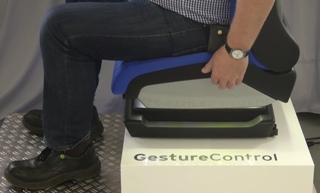Aug 4 2015
A multitude of professional drivers suffer from back problems. One cause: driver seats that are inadequately adjusted to each driver‘s ergonomic needs.
 Ease into the correct seat position: with the new seat model, a few hand gestures at the side panel are all you need. © Isringhausen GmbH
Ease into the correct seat position: with the new seat model, a few hand gestures at the side panel are all you need. © Isringhausen GmbH
Fraunhofer‘s researchers, in joint collaboration with Isringhausen GmbH & Co. KG, engineered a driver‘s seat whose shape and position can be adjusted by using simple hand gestures.
Sitting for hours on end with little movement: it‘s part of everyday working life for the professional driver. On average, they spend nine hours a day in the vehicle cabin. As a result, at some point a number of drivers develop problems with their back. In study after study, statutory health insurance was able to demonstrate that a driver‘s seat that is adjusted to the person at the wheel in terms of shape and position, can be an effective countermeasure to back pain. Certainly the majority of truck seats possess a wide selection of seat position options – yet the majority of drivers use them only sporadically, since operation is complicated and there often is not enough time for a correct setting.
A new, intuitive operating design should change all this. Researchers at the Fraunhofer Institute for Silicate Research ISC, in collaboration with Isringhausen GmbH & Co. KG., have engineered a driver‘s seat that can be calibrated intuitively through gestures. „To accomplish this, we use a sensor-based gesture control system in the driver‘s seat,“ explains Johannes Ehrlich of the Center for Smart Materials (CeSMa) at Fraunhofer ISC. „With the aid of simple hand gestures, the driver can move the seat forward and back, as well as up and down. In addition, he or she can also custom-set the incline of the thigh support and back rest in the same manner.“
Sensors that react to a brush of the hand
The scientists integrated various sensors into the synthetic side cover so that the seat reacts to the driver’s hand motions. Piezosensors are sensors that respond to pressure. They ensure that the motion-controlled system is activated. To do so, the user has to briefly press a certain point on the side cover. „This way we prevent the motion control from being accidentally triggered,“ Ehrlich explains. In addition, seat positions can be stored through this point by pressing several times. A useful option if multiple drivers are using the same truck. Proximity sensors that are likewise built into the side cover are used to detect gestures. They can track the smallest changes in electrical fields in the environment, such as when they are triggered through hand motions. Another software program likewise engineered at ISC reads these sensors and determines the hand‘s direction of motion from this. The arrangement of the sensors in the side panel is therefore of decisive importance. „We have attached electrodes to the relatively limited space, so that the necessary control gestures are easy and ergonomically favorable,“ explains Ehrlich. Moreover, an intelligent algorithm in the software guarantees that multiple electrodes can be evaluated simultaneously, thereby reducing incorrect operation.
In order to set the seat position, the driver performs brief hand motions along the entire side cover – you can more or less imagine this to be similar procedure to the „brushing“ motion on a touchscreen. That means that the driver only has to lightly touch the cover. Depending on the directional motion of the gesture (up/down, forward/back, diagonal), the individual seat elements are adjusted accordingly. Once the operator has performed the settings, the gesture control automatically shuts off as soon as the hand is moved away from the sensor area. The driver then receives confirmation that the gestures were stored successfully through an LED-instrument.
Isringhausen GmbH, together with the ISC scientists, has already realized a fully functional prototype of the sensor seat. It will be unveiled at the IAA in Frankfurt this year. Currently, the project partners are concentrating on the automotive market. Over the long term, the gesture-controlled seat may also be of interest to the middle and upper-class automotive market, in order to enhance driver comfort.